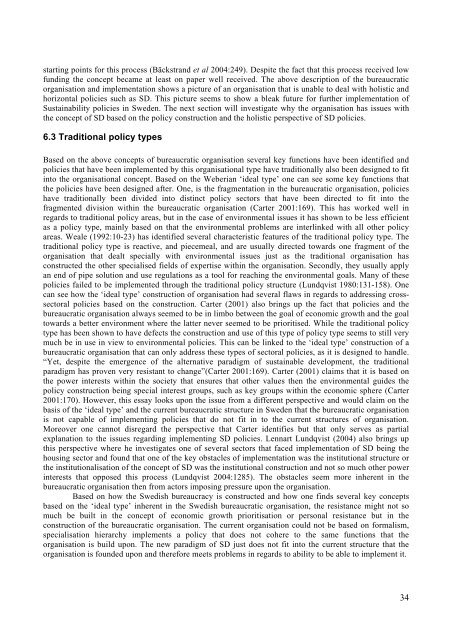From 'grey to green'- investigating the capabilities of the ... - lumes
From 'grey to green'- investigating the capabilities of the ... - lumes
From 'grey to green'- investigating the capabilities of the ... - lumes
Create successful ePaper yourself
Turn your PDF publications into a flip-book with our unique Google optimized e-Paper software.
starting points for this process (Bäckstrand et al 2004:249). Despite <strong>the</strong> fact that this process received lowfunding <strong>the</strong> concept became at least on paper well received. The above description <strong>of</strong> <strong>the</strong> bureaucraticorganisation and implementation shows a picture <strong>of</strong> an organisation that is unable <strong>to</strong> deal with holistic andhorizontal policies such as SD. This picture seems <strong>to</strong> show a bleak future for fur<strong>the</strong>r implementation <strong>of</strong>Sustainability policies in Sweden. The next section will investigate why <strong>the</strong> organisation has issues with<strong>the</strong> concept <strong>of</strong> SD based on <strong>the</strong> policy construction and <strong>the</strong> holistic perspective <strong>of</strong> SD policies.6.3 Traditional policy typesBased on <strong>the</strong> above concepts <strong>of</strong> bureaucratic organisation several key functions have been identified andpolicies that have been implemented by this organisational type have traditionally also been designed <strong>to</strong> fitin<strong>to</strong> <strong>the</strong> organisational concept. Based on <strong>the</strong> Weberian ‘ideal type’ one can see some key functions that<strong>the</strong> policies have been designed after. One, is <strong>the</strong> fragmentation in <strong>the</strong> bureaucratic organisation, policieshave traditionally been divided in<strong>to</strong> distinct policy sec<strong>to</strong>rs that have been directed <strong>to</strong> fit in<strong>to</strong> <strong>the</strong>fragmented division within <strong>the</strong> bureaucratic organisation (Carter 2001:169). This has worked well inregards <strong>to</strong> traditional policy areas, but in <strong>the</strong> case <strong>of</strong> environmental issues it has shown <strong>to</strong> be less efficientas a policy type, mainly based on that <strong>the</strong> environmental problems are interlinked with all o<strong>the</strong>r policyareas. Weale (1992:10-23) has identified several characteristic features <strong>of</strong> <strong>the</strong> traditional policy type. Thetraditional policy type is reactive, and piecemeal, and are usually directed <strong>to</strong>wards one fragment <strong>of</strong> <strong>the</strong>organisation that dealt specially with environmental issues just as <strong>the</strong> traditional organisation hasconstructed <strong>the</strong> o<strong>the</strong>r specialised fields <strong>of</strong> expertise within <strong>the</strong> organisation. Secondly, <strong>the</strong>y usually applyan end <strong>of</strong> pipe solution and use regulations as a <strong>to</strong>ol for reaching <strong>the</strong> environmental goals. Many <strong>of</strong> <strong>the</strong>sepolicies failed <strong>to</strong> be implemented through <strong>the</strong> traditional policy structure (Lundqvist 1980:131-158). Onecan see how <strong>the</strong> ‘ideal type’ construction <strong>of</strong> organisation had several flaws in regards <strong>to</strong> addressing crosssec<strong>to</strong>ralpolicies based on <strong>the</strong> construction. Carter (2001) also brings up <strong>the</strong> fact that policies and <strong>the</strong>bureaucratic organisation always seemed <strong>to</strong> be in limbo between <strong>the</strong> goal <strong>of</strong> economic growth and <strong>the</strong> goal<strong>to</strong>wards a better environment where <strong>the</strong> latter never seemed <strong>to</strong> be prioritised. While <strong>the</strong> traditional policytype has been shown <strong>to</strong> have defects <strong>the</strong> construction and use <strong>of</strong> this type <strong>of</strong> policy type seems <strong>to</strong> still verymuch be in use in view <strong>to</strong> environmental policies. This can be linked <strong>to</strong> <strong>the</strong> ‘ideal type’ construction <strong>of</strong> abureaucratic organisation that can only address <strong>the</strong>se types <strong>of</strong> sec<strong>to</strong>ral policies, as it is designed <strong>to</strong> handle.“Yet, despite <strong>the</strong> emergence <strong>of</strong> <strong>the</strong> alternative paradigm <strong>of</strong> sustainable development, <strong>the</strong> traditionalparadigm has proven very resistant <strong>to</strong> change”(Carter 2001:169). Carter (2001) claims that it is based on<strong>the</strong> power interests within <strong>the</strong> society that ensures that o<strong>the</strong>r values <strong>the</strong>n <strong>the</strong> environmental guides <strong>the</strong>policy construction being special interest groups, such as key groups within <strong>the</strong> economic sphere (Carter2001:170). However, this essay looks upon <strong>the</strong> issue from a different perspective and would claim on <strong>the</strong>basis <strong>of</strong> <strong>the</strong> ‘ideal type’ and <strong>the</strong> current bureaucratic structure in Sweden that <strong>the</strong> bureaucratic organisationis not capable <strong>of</strong> implementing policies that do not fit in <strong>to</strong> <strong>the</strong> current structures <strong>of</strong> organisation.Moreover one cannot disregard <strong>the</strong> perspective that Carter identifies but that only serves as partialexplanation <strong>to</strong> <strong>the</strong> issues regarding implementing SD policies. Lennart Lundqvist (2004) also brings upthis perspective where he investigates one <strong>of</strong> several sec<strong>to</strong>rs that faced implementation <strong>of</strong> SD being <strong>the</strong>housing sec<strong>to</strong>r and found that one <strong>of</strong> <strong>the</strong> key obstacles <strong>of</strong> implementation was <strong>the</strong> institutional structure or<strong>the</strong> institutionalisation <strong>of</strong> <strong>the</strong> concept <strong>of</strong> SD was <strong>the</strong> institutional construction and not so much o<strong>the</strong>r powerinterests that opposed this process (Lundqvist 2004:1285). The obstacles seem more inherent in <strong>the</strong>bureaucratic organisation <strong>the</strong>n from ac<strong>to</strong>rs imposing pressure upon <strong>the</strong> organisation.Based on how <strong>the</strong> Swedish bureaucracy is constructed and how one finds several key conceptsbased on <strong>the</strong> ‘ideal type’ inherent in <strong>the</strong> Swedish bureaucratic organisation, <strong>the</strong> resistance might not somuch be built in <strong>the</strong> concept <strong>of</strong> economic growth prioritisation or personal resistance but in <strong>the</strong>construction <strong>of</strong> <strong>the</strong> bureaucratic organisation. The current organisation could not be based on formalism,specialisation hierarchy implements a policy that does not cohere <strong>to</strong> <strong>the</strong> same functions that <strong>the</strong>organisation is build upon. The new paradigm <strong>of</strong> SD just does not fit in<strong>to</strong> <strong>the</strong> current structure that <strong>the</strong>organisation is founded upon and <strong>the</strong>refore meets problems in regards <strong>to</strong> ability <strong>to</strong> be able <strong>to</strong> implement it.34
















